Hi all,
Long time reader, first time poster here. I've been reading up on loadspeaker theory for months now and finally decided to start my first project. As per advice of this and other fora, I'm starting out small with a simple 2-way speaker to start learning the ropes. I picked the Dayton DSA90-8 to be my low-mids / bass speaker for this project as its Fs of 66Hz is quite low for its size (3"). I couldn't seem to find one that goes much lower, but I'm running into trouble with modeling the enclosure. While the manufacturer states that Fs is at 66Hz, and that its usable range is 66Hz-15kHz, I can't seem to end up with a box that comes anywhere close to making this happen (safely).
Below, I've attached images (8) of the response and cone excursion for a sealed box, sizes 0,3L (1&2), 0,7L (3&4) and two vented enclosures at 1,9L (5&6) and 0,6L (7&8). Naturally, there's more options, but I used these to illustrate my issue:
I can't seem to get anywhere near 66Hz with a speaker that doesn't exceed Xmax, or inversely, to get the driver to work at 66Hz without exceeding Xmax.
Now, I realise a sealed box will always produce an F3 way higher than the driver's Fs. However, the apparent need to go down all the way to 0,3L of enclosure volume seems a bit wierd to me. 0,3L is rather small, and it also ruins the flat response. In contrast, the 0,7L sealed enclosure exceeds Xmax by nearly an additional 2,5mm. This can't be good for the driver, right?
Alternatively, looking at the vented enclosures, I can only get down to an F3 of 107Hz as well. From what I've read, shouldn't vented systems be able to at least get the driver's Fs into the flat portion of the response? In trying to design a maximal flat response vented enclosure, I end up with the 0,6L design, which produces the same problem as the 0,7L closed one. Am I doing something wrong? Is the driver just rubbish? Too small? Shouldn't I expect to get such low frequencies with drivers like this? If so, how do manufactureres of, say, bluetooth speakers do it with even smaller drivers?
T/S parameters Dayton Audio DSA90-8:
Thanks in advance!
Long time reader, first time poster here. I've been reading up on loadspeaker theory for months now and finally decided to start my first project. As per advice of this and other fora, I'm starting out small with a simple 2-way speaker to start learning the ropes. I picked the Dayton DSA90-8 to be my low-mids / bass speaker for this project as its Fs of 66Hz is quite low for its size (3"). I couldn't seem to find one that goes much lower, but I'm running into trouble with modeling the enclosure. While the manufacturer states that Fs is at 66Hz, and that its usable range is 66Hz-15kHz, I can't seem to end up with a box that comes anywhere close to making this happen (safely).
Below, I've attached images (8) of the response and cone excursion for a sealed box, sizes 0,3L (1&2), 0,7L (3&4) and two vented enclosures at 1,9L (5&6) and 0,6L (7&8). Naturally, there's more options, but I used these to illustrate my issue:
I can't seem to get anywhere near 66Hz with a speaker that doesn't exceed Xmax, or inversely, to get the driver to work at 66Hz without exceeding Xmax.
Now, I realise a sealed box will always produce an F3 way higher than the driver's Fs. However, the apparent need to go down all the way to 0,3L of enclosure volume seems a bit wierd to me. 0,3L is rather small, and it also ruins the flat response. In contrast, the 0,7L sealed enclosure exceeds Xmax by nearly an additional 2,5mm. This can't be good for the driver, right?
Alternatively, looking at the vented enclosures, I can only get down to an F3 of 107Hz as well. From what I've read, shouldn't vented systems be able to at least get the driver's Fs into the flat portion of the response? In trying to design a maximal flat response vented enclosure, I end up with the 0,6L design, which produces the same problem as the 0,7L closed one. Am I doing something wrong? Is the driver just rubbish? Too small? Shouldn't I expect to get such low frequencies with drivers like this? If so, how do manufactureres of, say, bluetooth speakers do it with even smaller drivers?
T/S parameters Dayton Audio DSA90-8:
Code:
Zn 8 ohms
Re 6.6 ohms
Le 0.53 mH @ 1 kHz
Fs 66.62 Hz
Qms 2.15
Qes 0.45
Qts 0.37
Mms 3.5g
Cms 1.64 mm/N
Sd 31.2 cm²
Vd 7.8 cm³
BL 4.61 Tm
Vas 2.27 L
Xmax 2.5 mm
Vc dia 20.4 mm
SPL 84.7 dB @ 2.83V/1m
RMS 20 watts
Usable range 66 15,000 HzThanks in advance!
Attachments
-
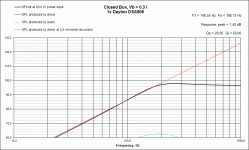 CB Response Dayton DSA908 Vb03.gif28.2 KB · Views: 508
CB Response Dayton DSA908 Vb03.gif28.2 KB · Views: 508 -
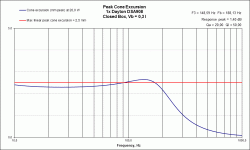 CB Excursion Dayton DSA908 Vb03.gif20.7 KB · Views: 542
CB Excursion Dayton DSA908 Vb03.gif20.7 KB · Views: 542 -
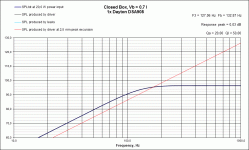 CB Response Dayton DSA908 Vb07.gif28.4 KB · Views: 521
CB Response Dayton DSA908 Vb07.gif28.4 KB · Views: 521 -
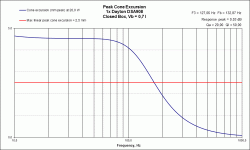 CB Excursion Dayton DSA908 Vb07.gif21.2 KB · Views: 508
CB Excursion Dayton DSA908 Vb07.gif21.2 KB · Views: 508 -
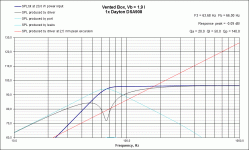 VB Response Dayton DSA908 Vb19.gif33.8 KB · Views: 508
VB Response Dayton DSA908 Vb19.gif33.8 KB · Views: 508 -
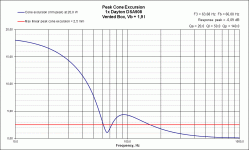 VB Excursion Dayton DSA908 Vb19.gif23.5 KB · Views: 264
VB Excursion Dayton DSA908 Vb19.gif23.5 KB · Views: 264 -
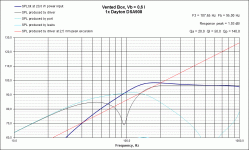 VB Response Dayton DSA908 Vb06.gif33.4 KB · Views: 164
VB Response Dayton DSA908 Vb06.gif33.4 KB · Views: 164 -
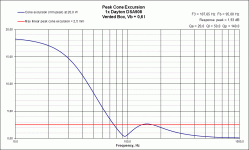 VB Excursion Dayton DSA908 Vb06.gif23.4 KB · Views: 150
VB Excursion Dayton DSA908 Vb06.gif23.4 KB · Views: 150
1.9 L vented enclosure looks OK (F3=63.68 Hz), in spite of 4.5 mm membrane amplitude. The driver will survive that.
Bluetooth speakers have DSP processing (compressor), limiting driver amplitude at low frequencies and higher wattage.
Bluetooth speakers have DSP processing (compressor), limiting driver amplitude at low frequencies and higher wattage.
I figure you mean cone excursion by membrane amplitude?
Anyway, how is 4,5mm OK? Won't the speaker distort if the voice coil starts going non-linear after exceeding Xmax? And how are you sure that the driver will be allright?
Anyway, how is 4,5mm OK? Won't the speaker distort if the voice coil starts going non-linear after exceeding Xmax? And how are you sure that the driver will be allright?
I think you mean cone excursion by membrane amplitude?
Anyway, how are you certain the driver will be OK? After the voice coil starts to behave non-linear, doesnt the driver start distorting, or worse, reach mechanical limitations?
Anyway, how are you certain the driver will be OK? After the voice coil starts to behave non-linear, doesnt the driver start distorting, or worse, reach mechanical limitations?
Anyway, how are you certain the driver will be OK? After the voice coil starts to behave non-linear, doesnt the driver start distorting, or worse, reach mechanical limitations?
The distortion increases with the excursion, it's not suddenly switched on at reaching the maximum linear excursion. With great excursion you'll get increased distortion (especally intermodulation) before the Xmax is exceeded if you use the driver in the mid aswell or fullrange. If you go over the maximum linear excursion, it gets worse also in the bass.
On a ported enclosure the membrane swings 'free' below the port frequency, which increases the distortion vastly. If it is forced to play below the fb, you get practically no higher loudness but all the disadvantages of the high excursion. To prevent huge excursion, a low cut filter a bit below the tuning frequency should be in place, and especally no +EQing below the fb! Sealed enclosures will profit from a lowcut greatly too and both will be able to play much louder undistorted.
Edit: A driver with a Qts of 0,37 is usually not suited well for a sealed enclosure anyway.
Right, that makes sense. Thanks. However, this doesn't answer my question. How is it that 4,5mm excursion should be OK?
I mean, 2mm beyond Xmax is sure to cause distortion right? So is this normal? Seems a bit weird to design a speaker that's going to sound shitty as soon as you turn it up half way or so.
Moreover, how are you certain 4,5mm won't cause mechanical damage? There's no limits listed on the sheet, so isn't that asking for trouble?
I mean, 2mm beyond Xmax is sure to cause distortion right? So is this normal? Seems a bit weird to design a speaker that's going to sound shitty as soon as you turn it up half way or so.
Moreover, how are you certain 4,5mm won't cause mechanical damage? There's no limits listed on the sheet, so isn't that asking for trouble?
How is it that 4,5mm excursion should be OK?
I mean, 2mm beyond Xmax is sure to cause distortion right? So is this normal? Seems a bit weird to design a speaker that's going to sound shitty as soon as you turn it up half way or so.
Yes, 2mm beyond Xmax is really sure to cause distortion. With 4,5mm excursion you'll get intermodulation distortion already. The Dayton DSA90-8does not have 4,5mm excursion, the Xmax is just 2,5mm. You've listed it yourself, it's not 4,5mm.
Moreover, how are you certain 4,5mm won't cause mechanical damage? There's no limits listed on the sheet, so isn't that asking for trouble?
The Xdmg is always quite much higher as the Xmax and some drivers got a progressive suspension which usually prevents them from crashing the VC into the back pole plate - which would damage the VC.
Very high membrane amplitude surely will cause mechanical damage ("bottoming" voice coil against plate), but usually Xmech is about 2 times Xmax, so you have about 5 mm living space. Of course there will be more distortion above 2.5 mm. By the way, you don't have to turn on all 20 watts. With 10 watts input power membrane amplitude will be less than 2.5 mm.Moreover, how are you certain 4,5mm won't cause mechanical damage? There's no limits listed on the sheet, so isn't that asking for trouble?
ICG gave good advice - use low cut filter below tuning frequency.
Yes, is the short answer. Driver is small so in order to reproduce LF it has to move further, and then your Xmax problem. There's no free lunch with sub freq, bigger is usually better.Too small?
But if you really want to use it, you can exceed the Xmax quite a bit without hurting it, as others have said.
Okay, thanks for all the great advice.
I guess I might not even need all the 20W of power, and the low-cut filter will take care of the bulk of my issues.
I guess I might not even need all the 20W of power, and the low-cut filter will take care of the bulk of my issues.
In the real world I've found driver excursion a lot less than shown in winISD due to actual music signals being played. I've had a driver from Fostex with an Xmax of around 1.5mm that should have issues with 1W but was fine with much more power when playing music.
ICG gave good advice - use low cut filter below tuning frequency.
To prevent huge excursion, a low cut filter a bit below the tuning frequency should be in place
So, I've taken some time to look into this advice, but I can't seem to find out how to do this. A passive high pass / low cut filter would require a huge capacitor: 10k uF to start at 60Hz. So apparently, active filters are used for lower frequencies to avoid such massive component values, but I can't for the life of me figure out why this would help.
I understand there's an OP-Amp involved in active filters, but I can't seem to find any source that explains clearly how I can use such a filter to cut at low frequencies without the need for huge value-components. Am I on the right path here? And is there anything I could search for / read up on to help me understand how and why to use an active high-pass?
Thanks again!
A passive first-order high-pass at 60 Hz would require about 330 uF when the resistance is 8 ohm. That's still a lot, but within the range you can get with bipolar electrolytics.
An active filter would normally be placed between preamplifier and main amplifier. The impedance levels they work with are usually in the 10 kohm ballpark, so for the same RC time constant, capacitances can be about three decades smaller than for a passive filter that is connected straight to an 8 ohm nominal load. Multiple feedback and Sallen and Key would be good search terms.
An active filter would normally be placed between preamplifier and main amplifier. The impedance levels they work with are usually in the 10 kohm ballpark, so for the same RC time constant, capacitances can be about three decades smaller than for a passive filter that is connected straight to an 8 ohm nominal load. Multiple feedback and Sallen and Key would be good search terms.
A passive first-order high-pass at 60 Hz would require about 330 uF when the resistance is 8 ohm. That's still a lot, but within the range you can get with bipolar electrolytics.
Well, that's just 6dB/Oct. Ofcourse that already helps but to avoid the huge excursion, it has to be much steeper. Okay, that depends on the loundess requirements too but passive it's just way too expensive, heavy and volume you're sacrificing to go for any higher order filter.
An active filter would normally be placed between preamplifier and main amplifier. The impedance levels they work with are usually in the 10 kohm ballpark, so for the same RC time constant, capacitances can be about three decades smaller than for a passive filter that is connected straight to an 8 ohm nominal load. Multiple feedback and Sallen and Key would be good search terms.
Yes, that's generally how the classical active filter is done. You can likely get away much cheaper and easier. If the sound source is a cell phone or tablet, you can get a dsp- or parametric equalizer app and let it do the soft- and hardware of the modern communications devices. It can take of the needed EQ-ing in the whole frequency range then too.
So, I've taken some time to look into this advice, but I can't seem to find out how to do this. A passive high pass / low cut filter would require a huge capacitor: 10k uF to start at 60Hz. So apparently, active filters are used for lower frequencies to avoid such massive component values, but I can't for the life of me figure out why this would help.
Music contains a lot of different frequencies. Even if the speaker can't reproduce them anymore, it still gets the power in that range. Because bassreflex doesn't take the energy away from the membrane below the tuning frequency, the enclosure doesn't keep it from moving extremely. You get distortion at quite low spl, the membrane wobbles, the driver terrified for its mechanical life. It's not loud, it sounds bad, you don't want that. Filter these frequencies out and everyone's happy and you can reach a much higher loudness clean and undistorted. Again: Just don't EQ it + below the tuning frequency! (Just the lowcut which is -)
I understand there's an OP-Amp involved in active filters, but I can't seem to find any source that explains clearly how I can use such a filter to cut at low frequencies without the need for huge value-components. Am I on the right path here? And is there anything I could search for / read up on to help me understand how and why to use an active high-pass?
The filters got to take the power of the signal. If it's passive (after the amp), the physical dimensions are huge because of the power. The size of the filters in an active filter is vastly different because it has only to deal with a tiny fraction of the power. The impedance there is much higher (ie. around 50k), that means your components got a lot different values. All in all a lot cheaper, less losses and much less space taken up.
Actually the capacity is related to the frequency, and the impedance but not to power.the physical dimensions are huge because of the power. The size of the filters in an active filter is vastly different because it has only to deal with a tiny fraction of the power.
To further understanding, I like to use passive filters within the amp to do the same job (you need to understand your amp before doing this). This way I benefit from the smaller capacitance that goes along with the higher impedance environment, and make use of an already existing filter by just resizing it.to help me understand how and why to use an active high-pass?
The reason that active filters are often used is for their practicality and their effectiveness, sometimes cost etc.
Actually the capacity is related to the frequency, and the impedance but not to power.
The value is ofcourse dependent on the impedance and the frequency. But since we don't want to change the frequency of the low cut filter, the frequency is already set and it falls off as parameter, that's why I did not mention it separately. The value is also dependent on the order of the filter, look i.e. at 1st and 2nd order and compare it.
It's physical size is actually really related to the voltage and capacity. If it's wound too tight or with to thin layers, the voltage will jump and burn a hole into the foils, that means, higher voltage ratings have to be physically thicker on an otherwise identical capacitor. That means, it will become bigger in dimensions, no way around that.
The reason that active filters are often used is for their practicality and their effectiveness, sometimes cost etc.
Uhm, no. Active filters aren't flexible, even adjustable ones are often not flexible enough or change their filter characteristics over the frequency range. DSPs are much more practical because they can be freely adjusted in frequency, filter characteristics, filter order, delay for ideal phase (which you can't achieve with an active - at least not with reasonable effort), you can adjust the response (no external EQ needed), implement peak- and/or rms-limiters and other things, save and recall settings in seconds. That's why they are so much more effective and even cheaper than an active crossovers and filters if you need more than just one thing. If you want a cheap DSP, look for the Sure/Wondom or the freedsp and there are others too.
To do it with an App is even free, uses a lot less power and is still as powerful, so that's the most practical and cheapest thing for this use.
Right on, thanks! That's a lot of info.
This would only ensure the 60Hz cutoff if the speaker is coupled to a phone/tablet that has the app and is set up properly, right? If so, it's unpractical, since if someone else besides me couples their device, the speakers lose their protection, so to speak. Although it is the easiest, and lowest-power option, I'm afraid it's not the way to go for this application.If the sound source is a cell phone or tablet, you can get a dsp- or parametric equalizer app and let it do the soft- and hardware of the modern communications devices.
Makes sense, but I only need it to do this one thing. I'm not too familiar with DSP's or the like, but it seems to me they're far more complex, and therefore draw much more power than an active crossover. Is this right? I'm thinking about making the speaker portable, so keeping power consumption low would be preferrable.That's why they are so much more effective and even cheaper than an active crossovers and filters if you need more than just one thing.
Will I need a pre-amp? If no, does this mean I'll just insert the filter in-line (between the bluetooth receiver and the amplifier)?An active filter would normally be placed between preamplifier and main amplifier.
Will I need a pre-amp? If no, does this mean I'll just insert the filter in-line (between the bluetooth receiver and the amplifier)?
You can simply insert it between the audio output of the Bluetooth receiver and the input of the amplifier.
- Status
- Not open for further replies.
- Home
- Loudspeakers
- Multi-Way
- Excessive cone excursion at low frequencies